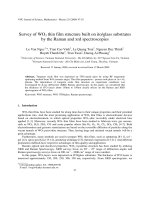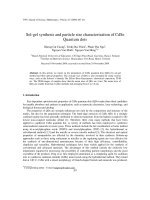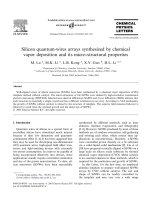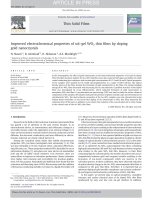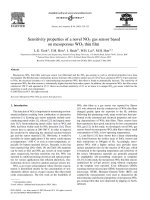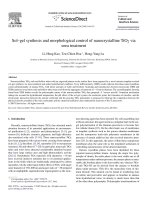- Trang chủ >>
- Khoa Học Tự Nhiên >>
- Vật lý
wo3 thin film sensor prepared by sol–gel technique and its low-temperature sensing properties to trimethylamine
Bạn đang xem bản rút gọn của tài liệu. Xem và tải ngay bản đầy đủ của tài liệu tại đây (159.23 KB, 4 trang )
Materials Chemistry and Physics 69 (2001) 176–179
WO
3
thin film sensor prepared by sol–gel technique and its
low-temperature sensing properties to trimethylamine
Maosong Tong, Guorui Dai
∗
, Dingsan Gao
Department of Electronic Engineering, National Integrated Optoelectronics Laboratory,
Jilin University, Changchun 130023, P. R. China
Received 20 April 2000; received in revised form 23 June 2000; accepted 1 July 2000
Abstract
Tungsten oxide (WO
3
) thin film has been prepared on a porcelain tube with gold comb-type electrodes by using a sol–gel technique with
WCl
6
as precursor. The X-ray diffraction and X-ray photoelectron spectrum results indicate the crystallization of tungsten oxide occurs at
temperatures higher than 500
◦
C. The sensing characteristics of the thin film sensor to trimethylamine were measured. A low-temperature,
high sensitivity, excellent selectivity, quick response and recover of thin film sensors to trimethylamine were found. © 2001 Elsevier
Science B.V. All rights reserved.
Keywords: Gas sensor; Sol–gel technique; Thin films; Trimethylamine; Tungsten oxide
1. Introduction
It is well known that the detection of fish freshness is
the most important problem in the fish-processing industry.
One of the most widely used methods of testing freshness is
chemically measuring the breakdown products of adenosine
triphophate-related compounds in the fish’s tissue, which re-
quires a great deal of effort and much time [1]. During the
deterioration of the fish after death, some gaseous species
such as trimethylamine (TMA), dimethylamine and ammo-
nia are given off. The concentration of these gases increases
with the decreasing of the fish-freshness. So the fish fresh-
ness can be monitored by a rapid, continuous, easy and
non-destructive way using a special gas sensor capable of
detecting TMA [2,3]. The previous studies of this gas sensor
were concentrated on TiO
2
-based materials. These sensors
are usually derived from ceramic processing and thick film
technology, however, they require high operating tempera-
ture, and are difficult to be miniaturized and incompatible
with the industrial technology of integrated circuits.
Such problems can be overcome by thin films [4,5]. The
thin film sensors can be fabricated by a number of tech-
niques, such as vacuum vaporization [6], radio frequency
(r.f.) sputtering [7], and chemical vapor deposition [8]. It is
well known that the sol–gel technique has several advan-
∗
Corresponding author. Tel.: +86-431-8923189; fax: +86-431-8923907.
E-mail address: (G. Dai).
tages, such as easy control of film thickness and porosity,
the ability to produce thin films at low cost and at low tem-
perature, and the ability to make homogeneous distribution
of the components. This technique is very useful to enhance
the gas sensitivity [9–11].
The aims of this work are to prepare WO
3
thin films
via a sol–gel process, using WCl
6
as a precursor and test
the sensing properties of thin films to TMA gas at the low
operating temperature of 70
◦
C.
2. Experimental
2.1. Thin film preparation
The WO
3
thin film was prepared by a sol–gel technique
using WCl
6
as a precursor. WCl
6
(99.95%) was dissolved
in isopropanol at a ratio of 5g/100ml and stayed in dry
air for 2 days. Then the obtained sol was deposited onto
the substrates by dip coating method. Prior to the coating
deposition the substrates were ultrasonically cleaned, first in
acetone then in isopropanol and deionized water, and dried
at 100
◦
C . The cleaned substrates were slowly dipped in the
solution at room temperature. The films showed a sudden
solution color change when they were gradually withdrawn
from the solution. This reflected that the hydrolysis reaction
took place as soon as the coatings were exposed to air. After
the hydrolysis and condensation, the gel films were dried in
0254-0584/01/$ – see front matter © 2001 Elsevier Science B.V. All rights reserved.
PII: S0254-0584(00)00389-8
M. Tong et al./ Materials Chemistry and Physics 69 (2001) 176–179 177
air at 120
◦
C for 15min. In order to obtain the crystalline
films, the heat treatment was performed on the dried films
at 150, 350 and 500
◦
C for 10 h.
2.2. Thin film characterization
The crystalline structures of the obtained thin films were
determined by X-ray diffraction (XRD) using a SIEMENS
D5005 apparatus with Cu K␣ radiation and Ni filter at room
temperature. The data were collected by a step scanning
method for the diffraction angle range 20
◦
≤ 2θ ≤ 60
◦
, with
a step width of 0.05
◦
and a step time of 1 s. The composi-
tion and oxidizing state of the thin films were investigated
using X-ray photoelectron spectroscopy (XPS), which were
carried out on an ESCALAB MARK-II XPS spectrometer
with Mg K␣ radiation. The working pressure in the analy-
sis chamber was maintained below 5 × 10
−7
Pa during the
specimen analysis. To eliminate the effect of sample surface
charging the shift of the XPS peak of carbon (C 1s whose
binding energy is 284.6eV) was used.
2.3. Measurements of gas sensing properties
WO
3
were deposited between interdigital gold electrodes
on the outer wall of a ceramic tube. The electrical contacts
were made with 0.05 mm gold wires attached to the gold
electrodes. Then the deposited thin film was annealed at
500
◦
C for 10 h. The thin film sensors were set up in a glass
test chamber with a volume of 0.18 m
3
and kept under a
continuous flow of fresh air for 10min before measurement.
The operating voltage (V
H
) was supplied to either of the
coils for heating the sensors and the circuit voltage (V
C
=
10 V) was supplied across the sensors and the load resistor
(R
L
= 2k) connected in series. The signal voltage across
the load, which changed with sort and concentration of gas,
was measured. The gas sensitivities to TMA, C
2
H
5
OH gas,
gasoline, CH
4
, CO, and water vapor were measured. A given
amount of each gas was injected into the chamber and mixed
by a fan for 30 s. The sensitivity to gases, S, is defined as
S = V
g
/V
a
, where V
g
and V
a
are the voltage drops across
the load resistance in testing gases/air mixture and in air,
respectively.
3. Results and discussion
3.1. The XRD and XPS analyses of the thin films
Fig. 1 shows the X-ray diffraction patterns of the films
that were deposited on Si wafers and annealed at different
temperatures for 10 h. The XRD pattern of the thin film an-
nealed at 150
◦
C does not show any definite structure. So
the sample annealed at this temperature was in the amor-
phous state (see Fig. 1(a)). When the sample was treated
at 350
◦
C, a few weak peaks can be observed in the XRD
Fig. 1. X-ray diffraction patterns of the thin films annealed at different
temperatures.
pattern and the result indicates that the sample was amor-
phous or in a weak polycrystalline state (see Fig. 1(b)). The
diffraction pattern recorded for the sample heated at 500
◦
C
for 10 h shows many sharp peaks which can be attributed to
(100), (200), (220), (221), (002) and (400) crystal planes of
WO
3
(see Fig. 1(c)). No other crystalline phases could be
detected in the film annealed at 500
◦
C for 10 h.
Fig. 2 shows the XPS spectra of the films, which were
deposited on Si substrates and annealed at 500
◦
C for 10 h.
The XPS survey scan spectrum of the sample is shown in
Fig. 2(a). The peaks of tungsten 4p
1/2
,4p
3/2
,4d
3/2
,4d
5/2
,
4f
5/2
,4f
7/2
and oxygen 1s (O 1s) can be detected in the
spectrum. The photoelectron peaks of chloride cannot be
observed in this spectrum. This indicates that the films an-
nealed at 500
◦
C for 5 h consist of only oxygen and tungsten
elements. As shown in Fig. 2(b), the photoelecton peak of
O 1s is found to lie at 530.2 eV, and is assigned to lattice
oxygen in the WO
3
crystal. As shown in Fig. 2(c), the pho-
toelectron peaks of W 4f
5/2
andW4f
7/2
are found to lie at
37.1 and 35.20 eV, respectively and are contributed to lattice
tungsten in the WO
3
crystal.
3.2. Gas sensing properties of the thin film sensors
In general, the sensitivity of the sensor is affected by the
operating temperature. Fig. 3 shows the relationship between
the gas sensitivity and the operating temperature of WO
3
thin film sensor to TMA gas with various concentrations. As
shown in Fig. 3, to 100 and 500 ppm (volume concentration)
of TMA, the optimum of the operating temperature is 70
◦
C.
To 700 and 1000 ppm TMA, the gas sensitivity reaches al-
most the highest value at 70
◦
C. When the operating temper-
ature is in the range of 70–85
◦
C, the sensitivity increases a
little. With further increasing of the operating temperature,
the sensitivity to TMA gas decreases. These results mean
178 M. Tong et al./Materials Chemistry and Physics 69 (2001) 176–179
Fig. 2. X-ray photoelectron spectra of the thin film annealed at 500
◦
C
for 10 h. (a) Survey scan spectrum, (b) O 1s peak, and (c) W 4f
5/2
and
W4f
7/2
peaks.
that the WO
3
thin film can be used to detect TMA at low
temperature.
Fig. 4 shows the relationship between the gas sensitivity
and TMA concentrations at 70
◦
C: the gas sensitivity of the
sensor increases with TMA concentration. The detectable
minimal concentration of TMA is 50 ppm and the gas sen-
sitivity is ∼3at70
◦
C. When the concentration of TMA is
higher than 100 ppm, the gas sensitivity increases linearly
with the TMA concentration.
This type of thin film sensor was also tested for its sen-
sitivity to other gases. Fig. 5 shows its sensitivity to TMA,
Fig. 3. Operating temperature dependence of the gas sensitivity for the
WO
3
thin film sensor in TMA gas with different concentrations.
Fig. 4. The relationship between the gas sensitivity and TMA concentration
at 70
◦
C.
NH
3
, gasoline, C
2
H
5
OH, CH
4
and CO at the same concen-
tration of 1000ppm and to water vapor. These experimental
results indicate that the WO
3
thin film sensor is very sensi-
tive to TMA at 50–85
◦
C, but not sensitive to NH
3
, gasoline,
C
2
H
5
OH, CH
4
and CO and water vapor. These results in-
dicate that the WO
3
thin film sensor prepared by a sol–gel
Fig. 5. The relationship between the gas sensitivity and operating tem-
perature to different gases at the same concentration of 1000 ppm and to
water vapor.
M. Tong et al./ Materials Chemistry and Physics 69 (2001) 176–179 179
Fig. 6. The typical gas response characteristic of the WO
3
thin film sensor
to 500 ppm TMA at 70
◦
C.
method has a high sensitivity and selectivity to TMA at
70
◦
C.
Fig. 6 shows the typical gas response characteristic of
the WO
3
thin film sensor. After an introduction of 500 ppm
TMA gas, the response appears immediately. The 90% re-
sponse time is 2.5 s and the 90% recovery time is 24 s. We
also tested the response behavior of the sensor to TMA gas
of different concentrations. The 90% response time to 100
and 1000 ppm TMA gas is 6.5 and 2 s, respectively. The
90% recover time to 100 and 1000 ppm TMA gas is 21 and
30 s, respectively.
4. Conclusions
Based on the present experiment results, we have shown
that WO
3
thin films can be prepared by a sol–gel process
using WCl
6
as a precursor. The WO
3
thin film sensor
provides a high sensitivity, excellent selectivity and quick re-
sponse behavior at 70
◦
C to TMA. These results indicate that
the WO
3
thin film sensor prepared by the sol–gel technique
can be used to detect TMA gas, e.g. the freshness of the
fish.
Acknowledgements
This work was supported by the Chinese Natural Science
Foundation (No.69776038).
References
[1] T. Saito, K. Arai, M. Matsuyoshi, Bull. Jpn. Soc. Sci. Fish 24 (1959)
749.
[2] M. Egashira, Y. Shimizi, Y. Takao, Chem. Lett. 195 (3) (1988) 389.
[3] Y. Takao, Y. Iwanaga, Y. Shimizu, M. Egashira, Sensors and
Actuators B 10 (1993) 229.
[4] G. Sberveglieri, P. Benussi, G. Coccoli, S. Groppelli, P. Nelli, Thin
Solid Films 186 (1990) 349.
[5] L. Bruno, C. Pijolat, R. Lalauze, Sensors and Actuators B 18/19
(1994) 195.
[6] C.H. Liu, L. Zhang, Y.J. He, Thin Solid Films 304 (1997) 13.
[7] T. Mochida, K. Kikuchi, T. Kondo, H. Ueno, Y. Matsuura, Sensors
and Actuators B 24/25 (1995) 433.
[8] S. Manorama, G. Sarala Devi, V.J. Rao, Appl. Phys. Lett. 64 (1994)
3163.
[9] M. Kanamori, M. Takeuchi, Y. Ohya, Y. Takahashi, Chem.Lett. 201
(1994) 2035.
[10] H.T. Sun, C. Cantalini, M. Faccio, M. Pelino, Thin Solid Films 269
(1995) 97.
[11] A. Wilson, J.D. Wright, J.J. Murphy, Sensors and Actuators B 18/19
(1994) 506.
